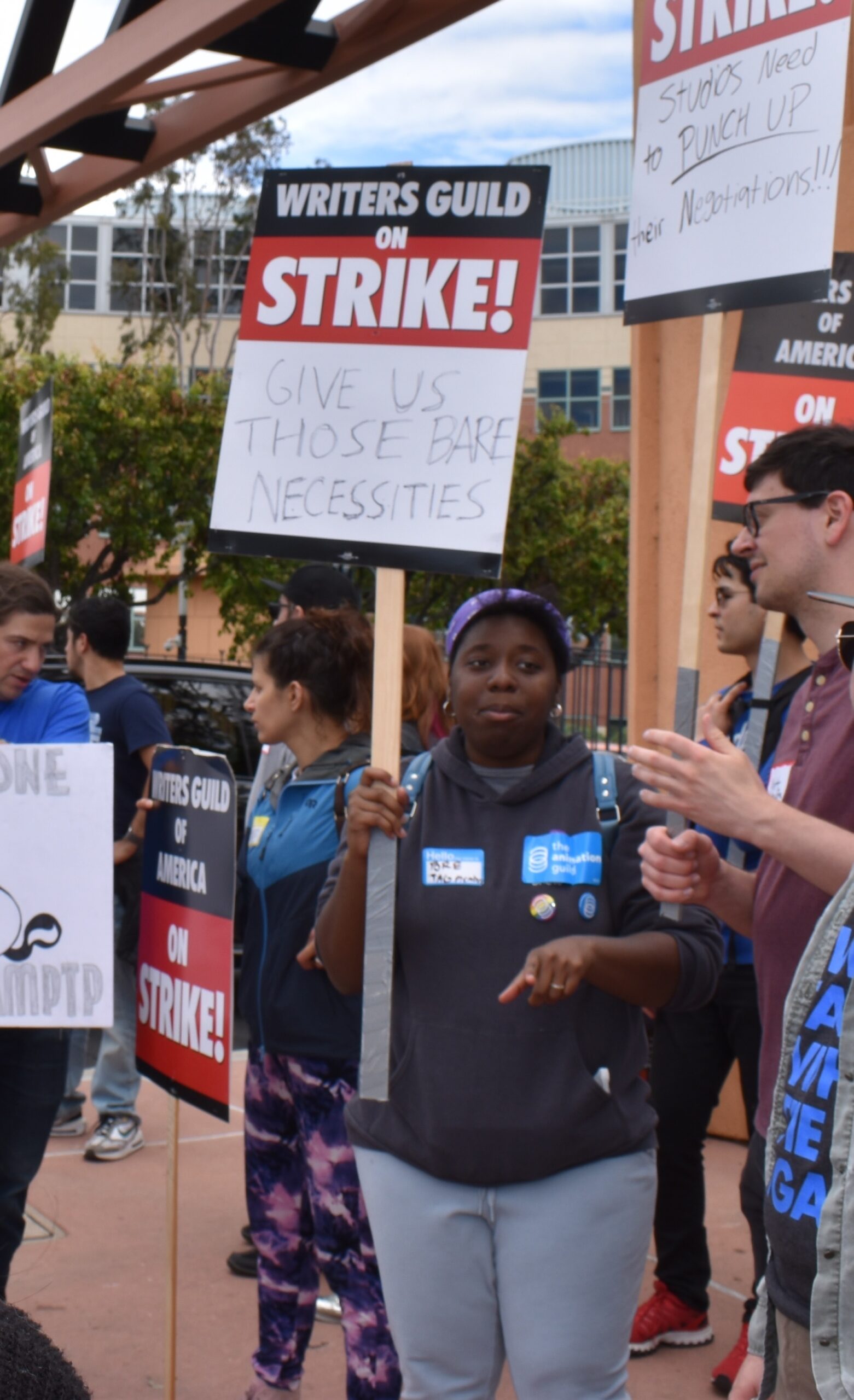
As the WGA and SAG-AFTRA strikes grip Hollywood, the potential impact of this pause in production and the climate creating the work stoppage presents unique challenges for women of color, who continue to dream of full participation in a business that is structurally more and more elusive to learn and grow within. Some question whether anything remotely close to the level of success of Hollywood’s top-earning writers and actors is even possible in today’s Hollywood run by avaricious corporations and tech giants.
On May 2 and July 14 respectively, the Writers Guild of America (WGA) and Screen Actors Guild–American Federation of Television and Radio Artists (SAG-AFTRA) opted to strike following stalled negotiations with the Alliance of Motion Picture and Television Producers (AMPTP), a trade association of feature and television producers across more than 350 companies. WGA is a union representing 20,000 writers in the United States, and SAG-AFTRA represents 160,000 actors and performers. After WGA called a strike about 80% of productions stopped, and after SAG-AFTRA joined, virtually the entire entertainment industry ground to a halt.
As the writer behind the theatrical film Respect (2021) about Aretha Franklin, WGA member and playwright Tracey Scott Wilson is part of a very small club of Black women screenwriters. In fact, in 2022 only 2.2% of the top 200 theatrical screen releases were by Black writers, and none were by Black women. “We are really fighting for our lives here,” says Wilson. “We are really fighting for a future because the progress [on diversity], particularly in the last four years, could be completely wiped away.” While theatrical writers of color are a small cohort, women of color have more opportunities in television. However, women of color are not getting promoted and moving up the ranks in television at the same rate as white men, white women, or men of color, in that order.
Like many of her peers, Wilson is deeply troubled by the issues WGA is working to address through the strike, such as low wages, nominal residuals, and increasingly limited opportunities to hone the craft. Most streamers and many broadcast and cable networks have reduced the size of writers rooms (to what are called mini rooms) and reduced the duration of the TV writing process from traditional network standards of 10+ months to as little as eight to 10 weeks with far fewer episodes. They have also started releasing writers before production and post-production so writers have less opportunity for on-set experience or understanding of the editing process, all of which would cultivate future showrunners. Additionally, the specter of unchecked AI could potentially reduce already limited writing opportunities. Wilson considers AI “the greatest spiritual crisis of our time because what does it mean to be a human being? When you take humanity out of [the creative process] you’re not creating art. I don’t even know what you’re creating, but you’re not creating art because there is no humanity in it.”
Dr. Ana-Christina Ramón is director of the Entertainment and Media Research Initiative at the UCLA Institute for Research on Labor and Employment. With Dr. Darnell Hunt, Ramón began co-authoring annual Hollywood Diversity Reports in 2011 tracking representation with a focus on writers, actors, and directors for both features and television. In that time, diversity in some areas has noticeably improved. For example, 92.6% of TV show creators were white in 2011 versus 73.4% in 2021. In feature films, 92.4% of writers were white in 2011, and 87.6% in 2022. As Ramón says, in 2011 “most of the shows and films were majority white, but during this time when we started doing the research, that’s when diversity conversations started [and] perhaps also the studios noticing … that there were markets that were untapped from different communities of color [leading to] more BIPOC in the supporting cast.”
According to the research, over this period diversity in casting increased much more than diversity in behind-the-scenes roles. As detailed in the 2022 Hollywood Diversity Report for television, 34.9% of broadcast shows are now “majority minority,” as are 35.8% in cable and 30.7% on streaming. However, casting actors of color in lead roles remains less common than casting them in supporting roles. Among writers, despite some increases, people of color are just 13.1% of show creators on broadcast, 26.6% on cable, and 25.6% on streaming. Women of color make up 17.8% of credited writers for broadcast, 20.9% for cable, and 18.9% for streaming; and men of color are 12.5% of credited writers for broadcast, 16.8% for cable, and 13.6% for streaming. People of color are 12.4% of screenwriters for theatrical and 20% for streaming. Although women of color tend to have strong representation at lower to mid-level writing positions, men of color are slightly more likely to be promoted to the executive producer level or above for TV and to pen screenplays for theatrical releases. Across all roles and formats white men have the most opportunities followed by white women.
Women of color writers and actors affected by the strike are navigating a Hollywood system slow to both include and cultivate diverse talent. And when they do, diversity in supporting cast and low- to midlevel writers is common while diversity in positions like lead roles and showrunners remains rare. Hollywood diversity, equity, and inclusion consultant Kristen Marston says, “I collaborate with development executives, writers rooms, advertisers, and racial justice advocates to produce television shows and films that authentically represent the lives and concerns of women, Black individuals, and communities of color.” Marston contends that the gains Ramón has observed in recent years could easily erode if emerging and established creatives are not nurtured or invested in to build their skills beyond the point of entry, saying, “Ultimately, the industry’s response to the ongoing strikes and willingness to address systemic issues will determine the feasibility of achieving” greater diversity, equity, and inclusion.
Melissa Silverstein, founder of Women and Hollywood and co-founder and artistic director of the Athena Film Festival, cited the “gigafication” of the industry fueled by the rise of streaming services, noting that Hollywood’s established creative and profit-sharing models are breaking down. “At the beginning … I don’t think people understood the implications of what it meant. Maybe people also didn’t understand that series television, as we grew up with [it], was going to disappear.” Absent a writers room (a 10- to 12-month job), a writer can work in a mini room and be held for eight to 10 weeks, unable to look for work while the studio decides whether to greenlight or renew a show. And even if the show is picked up, it’s unlikely those mini room writers will join the production if it’s an order of 10 episodes or less.
Silverstein continues: “When the [established creative and profit-sharing model] was broken, it was broken all in one side’s favor.” Before streaming, residuals from a project’s ongoing sale in other markets was a profit shared by those involved in the creative process. Under the new model, streamers and networks might pay top talent millions up front and neglect the back end (residuals) for creatives further down the line. “The back end is what people lived on [in between jobs],” Silverstein says. “When a model like that shifts so profoundly, so quickly, it’s led to upheaval, fear, and people saying, ‘We have to fight back—if we don’t stand up for the future there will be no jobs.”
Michelle Hurd is national vice president of Los Angeles SAG-AFTRA, a member of the negotiating committee, and an actress who plays Raffi Musiker on the Paramount+ series Star Trek: Picard. As a woman of color of mixed heritage who embraces her Black identity, Hurd is no stranger to the challenges of being different in a system that doesn’t always consider her point of view. Being a woman of color “is at the forefront of how I navigate my career,” Hurd says. “I have conscientiously, to the best of my ability, chosen roles as bosses, women in charge, people who have a voice.”
Hurd emphasizes a number of SAG-AFTRA demands such as options and exclusivity so series actors can work elsewhere during hiatus periods; AI as studios desire to digitally scan background actors to use their likeness in perpetuity without additional pay; raising actors’ minimums or caps for better pay and health insurance; increased access to intimacy coordinators (on-set safety being an issue Hurd is focused on as a member of the union’s sexual harassment prevention committee); increased revenue shares; and hair and makeup (HMU) equity — an issue that the union is pressing and which could have a direct impact on the work lives of actors of color. Hurd shared frightening tales of how bias in hair and makeup can be traumatic, from child actors of color being told their hair is “unkempt” to a story of a Black actor who was physically scarred after a white HMU artist shaved his textured facial hair incorrectly, scaring his face and forcing him to wear prosthetics for the rest of the shoot. Hurd invited him to speak to AMPTP during earlier negotiations and quoted him as saying, “I carry the shame upon my face of my inability to speak up for myself because I trusted the people hired to take care of me.” Hurd takes these as issues of basic respect, citing her own natural curly hair: “This is our crown. Optics matter.”
SAG-AFTRA actor Christina Chang is a regular on the ABC show The Good Doctor. She often receives messages from women in the medical profession expressing gratitude for her humanizing and inspiring portrayal of Dr. Audrey Lim, since there are few examples of women, especially Asian American women, in leadership in medicine on television. As an actress who started in theater, Chang is very cognizant of the recent improvements in AAPI representation and how easily they could recede if writers and actors of color can no longer afford to be in the business. “My almost 11-year-old daughter is getting to grow up in her world where she gets to see so many more people that look like her on screens. Period,” Chang says. “I’m excited about that [because] there is a difference between my growing up and kids today.”
Nevertheless, Chang says, “as a woman of color I have experienced what a lot of people are asking for in this strike: ‘Please pay me my worth. I’m a part of why this piece of content is valuable. Pay me my residuals.’ That’s kind of what I’ve always had to fight for individually; negotiating as David with Goliath, the studio, and having them say to me, ‘Who do you think you are? You are not worth what you think you are. You are dispensable. You are replaceable. And if you don’t fall in line, we will replace you.’ That is actually something I’ve heard the entire 26 years that I’ve been in this union. [This moment] is a larger, louder, unionized continuation of what I have experienced individually … this is a very important moment in history.”
Dual WGA and SAG-AFTRA member Monique Alvarez, who is of Cuban-Colombian heritage, vacillates between feelings of frustration and positive anticipation as the future of Hollywood hangs in the balance. After years of performing and a decade as a SAG-AFTRA member, she found it difficult to find material that represented her unique identity, so she decided to write it. Just before the strike, Alvarez had completed a pilot that she co-created with Jessica Lee Williamson called Hialeah: Dade F*ckin County, which drew inspiration from her hometown and cast diverse Latino actors for what would be one of the very few Latino-centered shows on television. For Alvarez, “part of what urged me to create a show is that it’s not something I’ve seen.” In fact, even though Latinos are nearly 20% of the U.S. population, according to the 2022 WGA Inclusion and Equity Report, Latino writers make up 5.9% of TV series writers, 3.2% of development/pilot writers, and 3.1% of screenwriters. According to the 2022 Hollywood Diversity Report for television, Latinos are 5.7% of lead actors on broadcast, 2.8% on cable, and 3.2% on streaming. In the 2023 report for film, Latino leads are 2.3% of lead actors for theatrical films and 6.1% for streaming.
Without a fair deal between the unions and AMPTP, underrepresented groups are likely to continue having problems gaining the opportunities that can lead to being a show creator, writer, and executive producer like Alvarez. Television and film entertainment, she points out, is a collaborative endeavor that “involves people from different unions and so many different kinds of working-class people, so this fight, being super important to the writers and the actors, impacts every single person on a crew and impacts so many other industries.”
WGA and SAG-AFTRA are resoundingly pushing back against the “gigafication” of entertainment in which once secure and skilled employees are systematically being reduced to gig workers with fewer protections. In this climate, women of color are both facing financial uncertainty and leading on the front lines, striving to protect the next generation of creatives. The advent of streaming has generated more film and television, providing more points of entry into the system, but many of these opportunities are unsustainable, from mini rooms to AI’s path toward creative consolidation and cost cutting. The gains of recent years for women of color in entertainment have been hard-fought and incremental, and are by no means guaranteed to continue. But women of color may well emerge from this experience with greater security like their 1960s strike counterparts — the last time writers and actors were on strike simultaneously and achieved improvements in pay, residuals, pensions, and health insurance. What is at stake is the future of an industry telling great, authentic stories that are made by a diversity of creators within an increasingly multiracial democracy.
More articles by Category:
Arts and culture,
Media
More articles by Tag:
Labor,
Labor unions,
Film,
Television,
Women of color
This post was originally published on this site be sure to check out more of their content.









